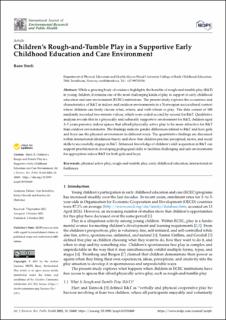Children’s Rough-and-Tumble Play in a Supportive Early Childhood Education and Care Environment
Peer reviewed, Journal article
Published version
Permanent lenke
https://hdl.handle.net/11250/2830456Utgivelsesdato
2021Metadata
Vis full innførselSamlinger
- Artikler (Articles) [176]
Originalversjon
International Journal of Environmental Research and Public Health (IJERPH). 2021, (18), 1-12. 10.3390/ijerph181910469Sammendrag
While a growing body of evidence highlights the benefits of rough-and-tumble play (R&T) in young children, it remains one of the most challenging kinds of play to support in early childhood education and care environment (ECEC) institutions. The present study explores the occurrence and characteristics of R&T in indoor and outdoor environments in a Norwegian sociocultural context where children can freely choose what, where, and with whom to play. The data consist of 100 randomly recorded two-minute videos, which were coded second by second for R&T. Qualitative analysis reveals that in a physically and culturally supportive environment for R&T, children aged 3–5 years perceive indoor spaces that afford physically active play to be more attractive for R&T than outdoor environments. The findings indicate gender differences related to R&T and how girls and boys use the physical environment in different ways. The quantitative findings are discussed within interactional affordances theory and show that children practise perceptual, motor, and social skills to successfully engage in R&T. Enhanced knowledge of children’s skill acquisition in R&T can support practitioners in developing pedagogical skills to facilitate challenging and safe environments for appropriate indoor R&T for both girls and boys.

